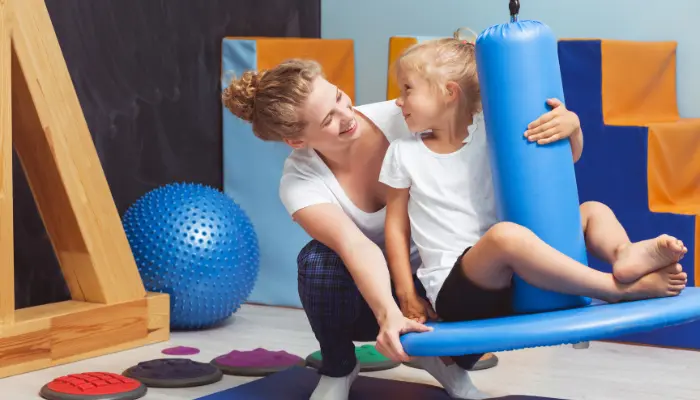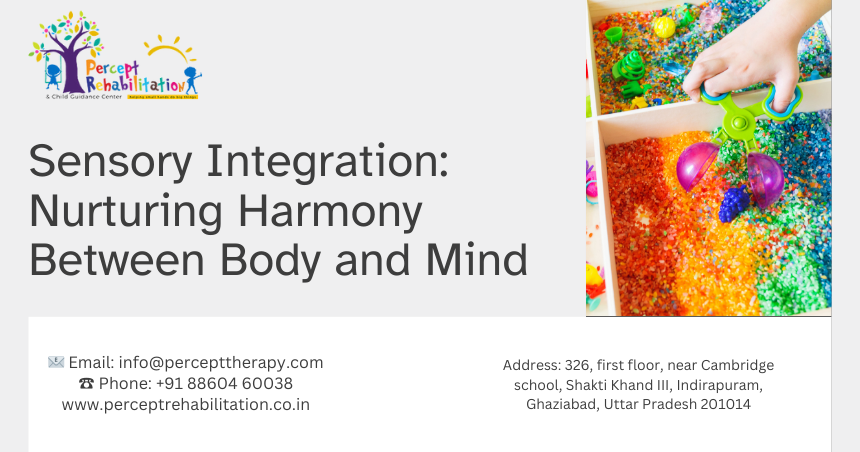Parents often notice subtle behaviors in their children that don’t quite align with what’s typical for their age. Some children may seem overly sensitive to sounds, lights, or textures, while others might appear unbothered by sensations most would react to. These signs might point toward a neurological condition known as Sensory Processing Disorder (SPD). Recognizing SPD early can lead to significant improvements in a child’s daily functioning and emotional regulation. For those seeking support, the best sensory integration therapy in Ghaziabad is offered at Percept Rehabilitation Centre, where individualized approaches meet expert care for children navigating these challenges.
What is Sensory Processing Disorder?
Sensory Processing Disorder refers to the brain’s difficulty in receiving, organizing, and responding to sensory information. This information may come from touch, smell, taste, sight, sound, or movement. For children with SPD, the brain either overreacts or underreacts to this input, making everyday experiences overwhelming or underwhelming.
SPD can affect one or more senses. Some children react strongly to certain clothing textures, while others may not notice pain or temperature changes. These sensory issues can significantly impact a child’s social skills, academic performance, emotional development, and daily functioning.
Common Signs of Sensory Processing Disorder
Every child is different, and so are the symptoms of SPD. While no two experiences are identical, there are several frequently observed patterns that can signal sensory challenges. Recognizing these early signs can help parents take timely action:
1. Over-Responsiveness (Hypersensitivity)
Children who are overly sensitive to sensory input may:
- Cover their ears at moderate sounds or common noises
- Avoid messy play like finger painting or sand
- Refuse to wear clothes with tags or seams
- Complain about bright lights or certain smells
- Cry or withdraw in busy or noisy environments
2. Under-Responsiveness (Hyposensitivity)
Some children do not respond adequately to sensory input. Signs may include:
- High pain tolerance or not noticing injuries
- Constant movement—jumping, crashing, spinning
- Difficulty sitting still or focusing
- Seeking loud noises or visual stimuli
- Unaware of personal space or boundaries
3. Sensory Seeking Behaviors
Children may actively seek intense sensory experiences:
- Excessive touching of people or objects
- Fascination with spinning or flashing lights
- Chewing on clothes, pencils, or other non-food items
- Repeated crashing into walls or furniture
- Jumping from heights without fear
Impact of SPD on Daily Life
Children with sensory processing difficulties may struggle in environments that most others navigate with ease. Simple tasks such as brushing teeth, wearing socks, attending school, or playing with peers can become frustrating or distressing.
These difficulties may manifest as:
- Delays in motor skills like balance, coordination, or handwriting
- Frequent tantrums or meltdowns, especially in unfamiliar settings
- Avoidance of playgrounds or noisy places
- Difficulty transitioning between tasks or environments
- Struggles with feeding, such as picky eating or texture refusal
Early recognition and structured intervention can dramatically change outcomes, reducing distress and enabling smoother engagement with daily routines.
Differences Between SPD and Other Conditions
It’s important to differentiate SPD from other developmental or behavioral conditions. While SPD may occur independently, it often overlaps with conditions such as:
- Autism Spectrum Disorder (ASD): Many autistic children experience sensory sensitivities, but SPD can exist without the social and communication challenges associated with ASD.
- ADHD: Children with ADHD may seek sensory input, but their core difficulties are related to attention and impulsivity.
- Anxiety: Sensory overload can appear similar to anxiety symptoms; however, the root cause may be the sensory system’s dysregulation.
Professional evaluation helps determine the underlying causes of a child’s challenges, guiding the best course of support.
What Causes Sensory Processing Disorder?
The exact cause of SPD remains unclear. However, contributing factors may include:
- Genetic predisposition or family history of sensory issues
- Premature birth or low birth weight
- Prenatal complications
- Environmental influences or early trauma
The central nervous system’s processing mechanisms may be affected during development, leading to atypical responses to sensory information. It is not the result of parenting style or behavioral discipline.
When Should Parents Seek Help?
Early intervention is key. Parents should consider consulting a professional if their child:
- Avoids or craves specific sensory experiences to an extreme degree
- Displays frequent meltdowns that seem tied to sensory input
- Struggles with motor skills, balance, or coordination
- Reacts emotionally to minor changes in clothing, food, or environment
- Faces consistent challenges with focus or transitions
Children with SPD do not simply “grow out of it.” Timely evaluation and intervention can significantly support their development and comfort in daily activities.
Role of Occupational Therapy in Treating SPD
Occupational therapy plays a crucial role in helping children with SPD function effectively in their environments. Through structured activities, children learn to respond more appropriately to sensory input and build critical motor, cognitive, and social skills.
Occupational therapy sessions typically involve:
- Activities that challenge the child’s vestibular, tactile, and proprioceptive systems
- Play-based interactions that gradually increase tolerance to sensory stimuli
- Techniques that help regulate arousal levels, reduce anxiety, and improve attention
- Parent training to reinforce strategies at home
Therapists design personalized intervention plans based on each child’s sensory profile and functional goals.
Types of Sensory Integration Techniques Used in Therapy
Different techniques are used based on the child’s specific needs. Common strategies include:
- Brushing Protocol (Wilbarger Method): A sensory-based technique to calm the nervous system
- Swing Therapy: Enhances vestibular input and balance control
- Therapeutic Listening: Helps regulate auditory processing and focus
- Proprioceptive Input Activities: Jumping, pushing, pulling to organize sensory signals
- Tactile Bins: Exposure to various textures to improve tactile processing
These approaches are carefully administered and monitored by trained therapists to ensure safe and effective sensory integration.
Tips for Supporting a Child with SPD at Home
Parents play a vital role in their child’s sensory development. Creating a supportive home environment makes a noticeable difference in how children experience and interact with the world. Here are some strategies to consider:
1. Create Sensory-Friendly Spaces
- Set up a quiet corner with soft lighting and calming tools
- Use noise-canceling headphones during noisy events
- Introduce calming scents and soft textures in clothing and bedding
2. Establish Routines
- Predictable schedules help children feel secure
- Use visual charts or timers to support transitions
3. Encourage Sensory Play
- Activities like water play, finger painting, sand pits, and dough modeling
- Include gross motor activities like obstacle courses or trampoline time
4. Practice Deep Pressure Techniques
- Weighted blankets or tight hugs can provide comfort
- Compression garments or pressure vests for a calming effect
5. Monitor Diet and Sensory Preferences
- Identify food textures or smells that trigger reactions
- Offer preferred textures while slowly introducing new ones
What to Expect During a Sensory Evaluation?
Evaluation involves a comprehensive assessment by an occupational therapist to determine how the child processes and responds to sensory information. This includes:
- Parent interviews and developmental history
- Direct observation during play and task performance
- Standardized tools like the Sensory Profile or Sensory Processing Measure
- Functional assessments focusing on daily routines and participation
Based on findings, a detailed intervention plan is created to address specific challenges, enhance coping strategies, and improve daily functioning.
Long-Term Support and Progress
Sensory processing challenges require consistent, long-term strategies. While therapy plays a central role, consistent support from families and schools ensures better outcomes. With time, children can develop improved regulation, social interaction, emotional control, and academic success.
Key areas where progress is often observed include:
- Better tolerance to new environments
- Improved focus and behavior at school
- Enhanced communication and play skills
- Greater independence in self-care tasks
- Reduced frequency and intensity of meltdowns
Regular reassessment and adjustment of goals are essential as the child grows and encounters new developmental stages.
Why Choose Percept Rehabilitation Centre?
Percept Rehabilitation Centre is a trusted provider of holistic pediatric therapy services. Our sensory integration programs are structured to meet each child’s sensory profile. With a deep commitment to enhancing children’s quality of life, our therapists focus on fostering independence, emotional regulation, and joyful participation in daily routines.
We offer a nurturing, well-equipped environment where children can explore, adapt, and grow at their own pace. At Percept, families receive not just therapy but a partner in their child’s journey toward comfort, resilience, and self-confidence.



